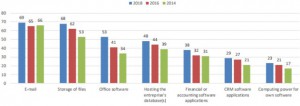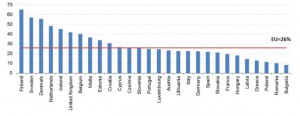
Published Winning Projects within the Network of Student Entrepreneurship Incubators Program!
14/12/2018
The most common startup mistakes and how to avoid them?
18/12/2018In 2018 In 2016, 26 percent of EU companies with at least 10 employees purchased cloud computing services, according to a Eurostat survey on the use of information and communication technologies among entrepreneurs in the European Union. In Croatia, cloud services, i.e. cloud computing, are used by 31 percent of companies with more than ten employees , which is above the European Union average.
The acceptance of cloud computing has been growing rapidly in the last few years : in 2014. it was used by 19 percent of companies, and in 2016 21 percent. As expected, large companies with more than 250 employees are more likely to adopt the cloud than small companies with 10 to 49 employees: 56 percent of large companies versus 23 percent of small companies.
In the last four years (2014-2018), the largest increase in the use of cloud computing was recorded in large companies (+21 percentage points). In the case of medium-sized companies, the growth was 12 percentage points, and in the case of small companies, it was 6 percentage points.
The research showed significant differences in the application of cloud computing with regard to the geographical location of countries. Thus, in the Nordic countries – Finland (65%), Sweden (57%) and Denmark (56%) – more than half of the companies use cloud computing services. On the other hand, there are Romania and Bulgaria, where cloud computing services are used by 10 and 8 percent of companies, respectively.

Cloud computing deployment in the EU by type of service, 2018 (% of companies deploying cloud computing services)
In 2018 , companies from cloud computing services mostly used e-mail (69% of companies that used the cloud), and only slightly fewer used the service of storing electronic files in the cloud (68%). Significantly fewer companies used cloud computing services to run their own software (23%) or CRM applications to manage customer information (29%).
The amount of digital data created, stored and processed is growing exponentially. Every activity carried out online or by means of information and communication technologies generates a series of digital footprints that, given their volume, variety and speed, form what we call “Big Data”. Only 12 percent of companies in the European Union with at least 10 employees used Big Data tools to analyze that data , the research shows. Such tools are used mainly by large (33%) and medium-sized companies (19%), and analyzes are carried out by internal staff (8%) or external service providers (5%).
Big Data analysis is most often applied in Malta (24%) , the Netherlands (22%), Belgium and Ireland (20% each). In Cyprus, on the other hand, 5 percent of companies use Big Data analysis, while Hungary and Austria (6% each) and Bulgaria and Italy (7% each) recorded slightly better results. In Croatia, Big Data tools are used by 10 percent of companies, which means that we are below the EU average.
Almost half of the companies (49%) that apply Big Data analytics analyze geolocation data collected via mobile devices . This is followed by the analysis of data collected via social networks (45%), and less than one third of companies analyzed data collected by their own smart devices or sensors (29%). 26 percent of companies analyzed data from other sources.
3D printing technology in 2018. it used, according to Eurostat research, only 4 percent of companies in the European Union . Among large companies, 13 percent of respondents used 3D printing, compared to only 3 percent of small companies.
3D printing is mostly used in Finland (7%) , Denmark, Malta, the United Kingdom and Belgium (6% each). In Latvia and Cyprus, only one percent of companies use this technology, and in Estonia, Bulgaria, Greece, Hungary, Romania and Poland, two percent. Croatia is slightly better with 3 percent of companies using 3D printing, but still below the EU average.
More than half of the companies (57%) that use 3D printing use this technology to create prototypes or models for internal use . Less than a third use 3D printing to create prototypes or models for sale (32%) or to create products that are used in the manufacturing process (27%). Only 17 percent of companies used 3D printing to create products other than prototypes or models for sale .



























